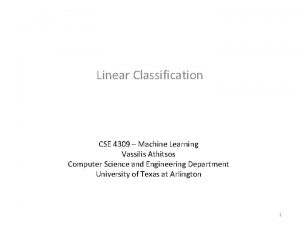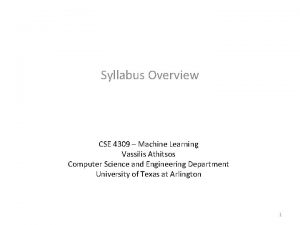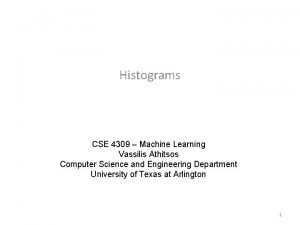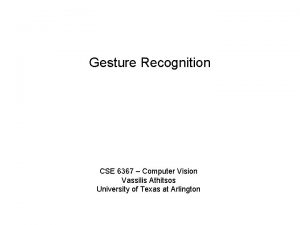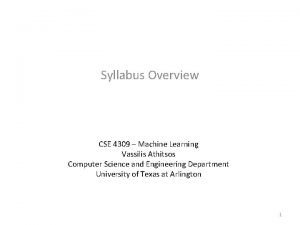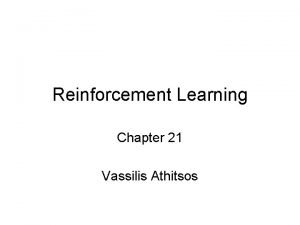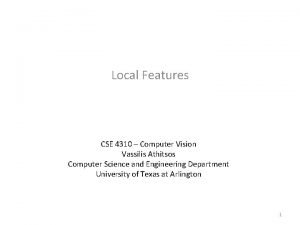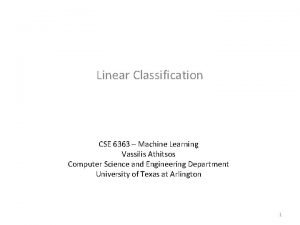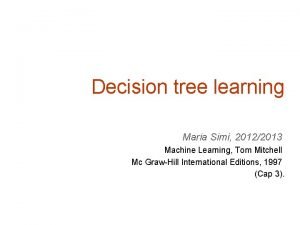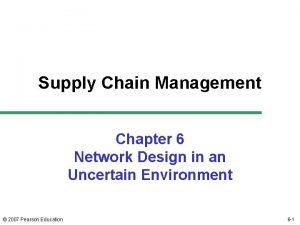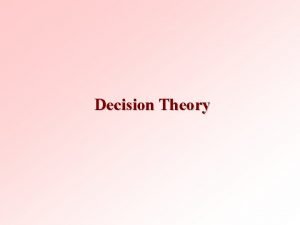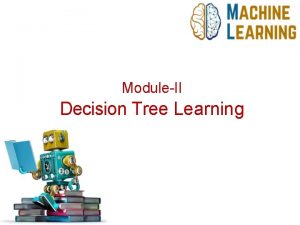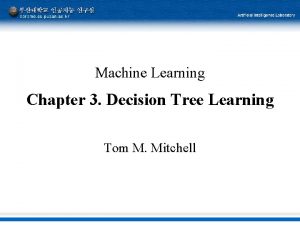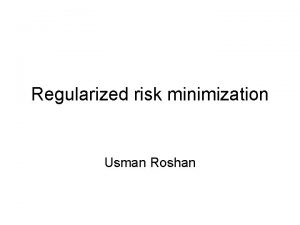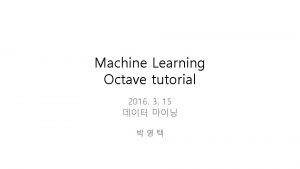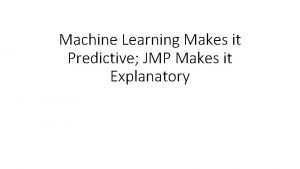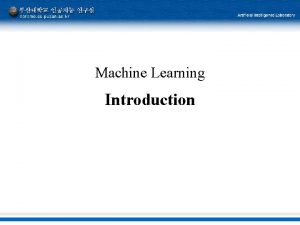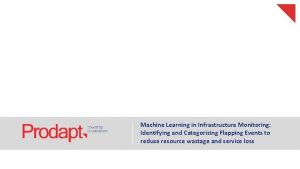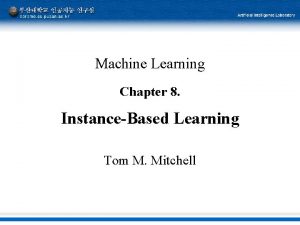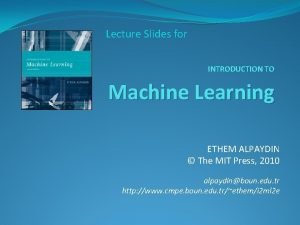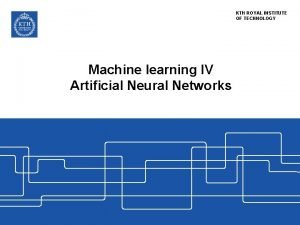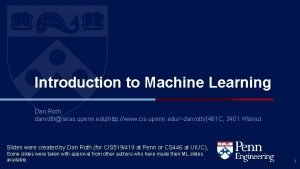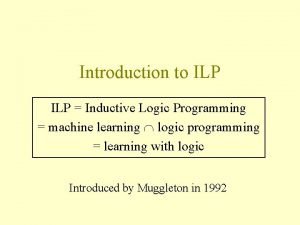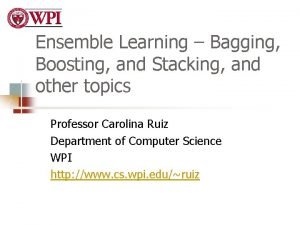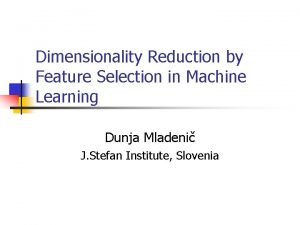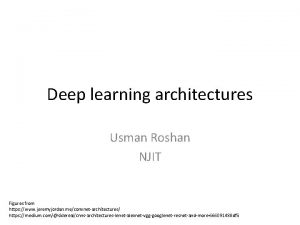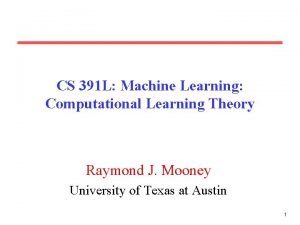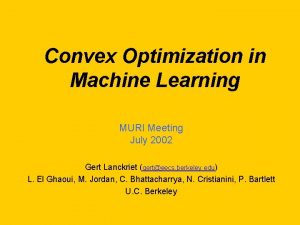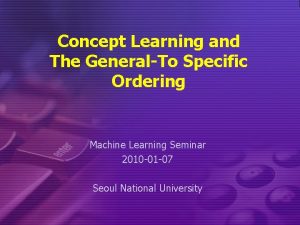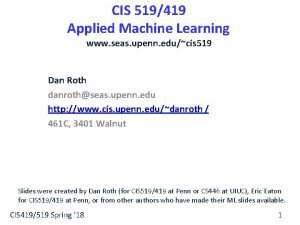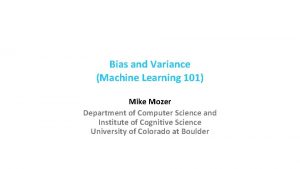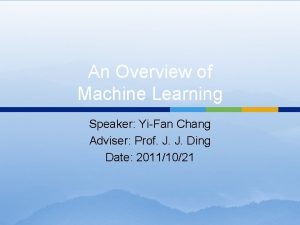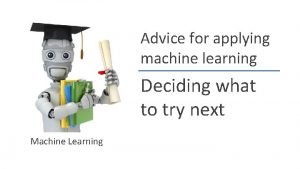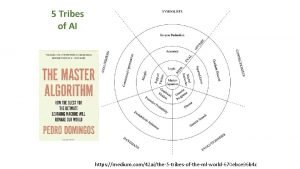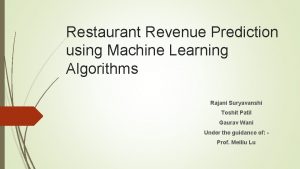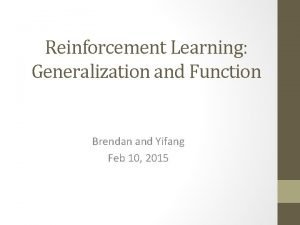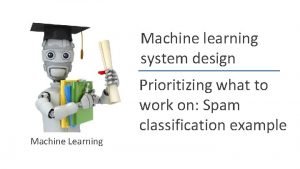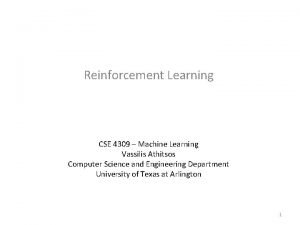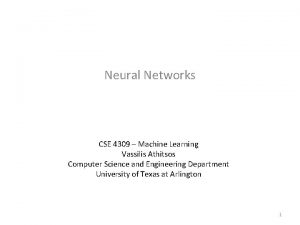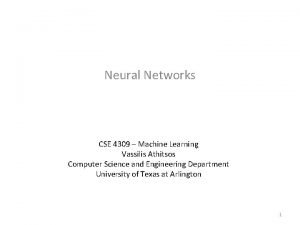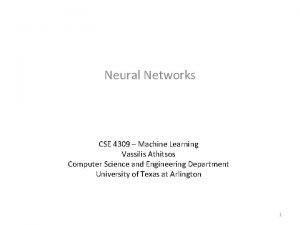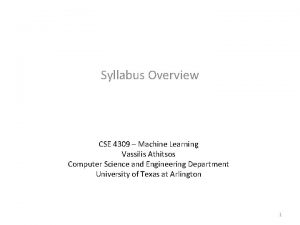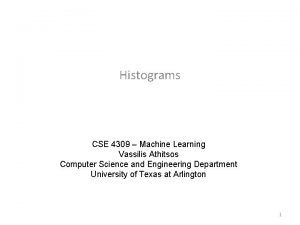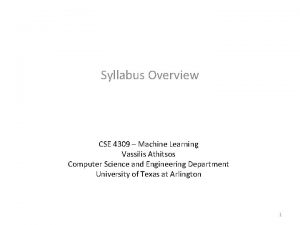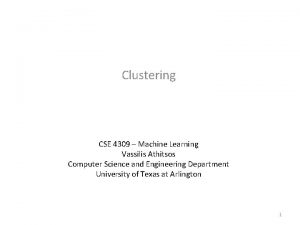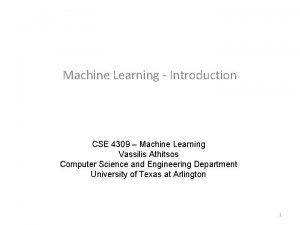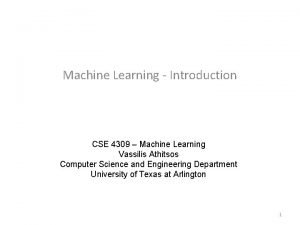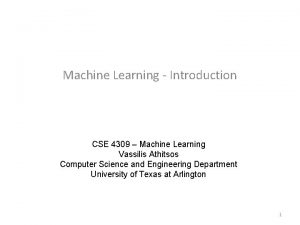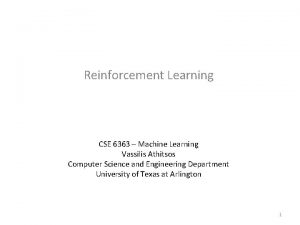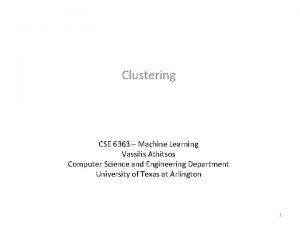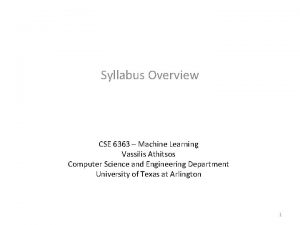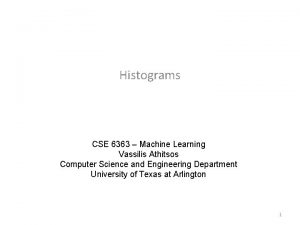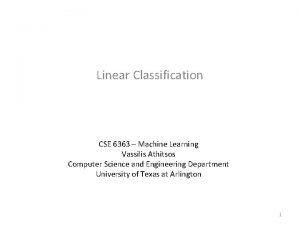Decision Trees CSE 4309 Machine Learning Vassilis Athitsos












































































- Slides: 76

Decision Trees CSE 4309 – Machine Learning Vassilis Athitsos Computer Science and Engineering Department University of Texas at Arlington 1

An Example of a Learning Problem Credit: This example is from: S. Russell and P. Norvig, "Artificial Intelligence: A Modern Approach", third edition (2009), Prentice Hall. 2

An Example of a Learning Problem • Some attributes are boolean, like Alt (are there alternative restaurants nearby? ), Bar (does the restaurant have a bar? ), Fri (is it weekend? ), Hun (is the customer hungry? ), Rain (is it raining? ), Res (was a reservation made? ) 3

An Example of a Learning Problem • Attribute Pat (how many people are in the restaurant) takes three values. • Attribute Price takes three values. Attribute Type takes four values. • Attribute Est (estimated wait time) takes four values. 4

An Example of a Learning Problem • Using these training examples, we want to learn a function F, mapping each pattern into a boolean answer (will wait, or will not wait). 5

Decision Trees • • • A decision tree is a type of classifier. The input is a pattern. The output is a class. Given a pattern: we start at the root of the tree. The current node asks a question about the pattern. Based on the answer, we move to a child of the current node. When we get to a leaf node, we get the output of the decision tree (a class). 6

Decision Trees • For example, what is the output of the decision tree on this pattern? Alt Bar Fri Hun Pat Price Rain Res Type Est F T F F Some $$ T F Thai 10 -30 7

Decision Trees • For example, what is the output of the decision tree on this pattern? Alt Bar Fri Hun Pat Price Rain Res Type Est F T F F Some $$ T F Thai 10 -30 • First check: ? ? ? 8

Decision Trees • For example, what is the output of the decision tree on this pattern? Alt Bar Fri Hun Pat Price Rain Res Type Est F T F F Some $$ T F Thai 10 -30 • First check: value of Patrons? Some. • Where do we go next? 9

Decision Trees • For example, what is the output of the decision tree on this pattern? Alt Bar Fri Hun Pat Price Rain Res Type Est F T F F Some $$ T F Thai 10 -30 • First check: value of Patrons? Some. • Where do we go next? To the middle child. What happens next? 10

Decision Trees • For example, what is the output of the decision tree on this pattern? Alt Bar Fri Hun Pat Price Rain Res Type Est F T F F Some $$ T F Thai 10 -30 • First check: value of Patrons? Some. • Where do we go next? To the middle child. Leaf node, output is will wait. 11

Decision Trees • What is the output of the decision tree on this pattern? Alt Bar Fri Hun Pat Price Rain Res Type Est F T F F Full $$ T F Thai 10 -30 • First check: ? ? ? 12

Decision Trees • What is the output of the decision tree on this pattern? Alt Bar Fri Hun Pat Price Rain Res Type Est F T F F Full $$ T F Thai 10 -30 • First check: value of Patrons? Full. • Where do we go next? 13

Decision Trees • What is the output of the decision tree on this pattern? Alt Bar Fri Hun Pat Price Rain Res Type Est F T F F Full $$ T F Thai 10 -30 • First check: value of Patrons? Full. • Where do we go next? To the right child. 14

Decision Trees • What is the output of the decision tree on this pattern? Alt Bar Fri Hun Pat Price Rain Res Type Est F T F F Full $$ T F Thai 10 -30 • Next check: ? ? ? 15

Decision Trees • What is the output of the decision tree on this pattern? Alt Bar Fri Hun Pat Price Rain Res Type Est F T F F Full $$ T F Thai 10 -30 • Next check: value of Wait. Estimate? 10 -30. • Where do we go next? To the second-from-the-right child. 16

Decision Trees • What is the output of the decision tree on this pattern? Alt Bar Fri Hun Pat Price Rain Res Type Est F T F F Full $$ T F Thai 10 -30 • Next check: value of Hungry? False. • Where do we go next? To the left child. 17

Decision Trees • What is the output of the decision tree on this pattern? Alt Bar Fri Hun Pat Price Rain Res Type Est F T F F Full $$ T F Thai 10 -30 • We arrived at a leaf node. • Output: will wait. 18

Decision Trees • At this point, it should be clear how to apply a decision tree to classify a pattern. • Obviously, there are lots and lots of different decision trees that we can come up with. 19

Decision Trees • At this point, it should be clear how to apply a decision tree to classify a pattern. • Obviously, there are lots and lots of different decision trees that we can come up with. • Here is a different decision tree. 20

Decision Trees • The natural question is: how can we construct a good decision tree? • The next slides address that question. 21

Decision Tree Learning function DTL_Top. Level(examples) returns a decision tree attributes = list of all attributes in the examples default = MODE(examples) return DTL(examples, attributes, default) • DTL_Top. Level is the top level function for decision tree learning. • It defines two variables (attributes and default), and calls the DTL function. – DTL (explained in the next slides) is an auxiliary function that does the actual work. • DTL is recursive, so the job of DTL_Top. Level is to just make the first call to DTL, with the right arguments. 22

Decision Tree Learning function DTL(examples, attributes, default) returns a decision tree if examples is empty then return default else if all examples have the same class then return the class else if attributes is empty then return MODE(examples) else best = CHOOSE-ATTRIBUTE(attributes, examples) tree = a new decision tree with root test best for each value vi of best do examplesi = {elements of examples with best = vi} subtree = DTL(examplesi, attributes - best, MODE(examples)) add a branch to tree with label vi and subtree return tree Credit: This pseudocode is from: S. Russell and P. Norvig, "Artificial Intelligence: A Modern Approach", third edition (2009), Prentice Hall. 23

Decision Tree Learning function DTL(examples, attributes, default) returns a decision tree if examples is empty then return default else if all examples have the same class then return the class else if attributes is empty then return MODE(examples) else best = CHOOSE-ATTRIBUTE(attributes, examples) tree = a new decision tree with root test best for each value vi of best do examplesi = {elements of examples with best = vi} subtree = DTL(examplesi, attributes - best, MODE(examples)) add a branch to tree with label vi and subtree return tree • Notice that the function is recursive (the line of the recursive call is highlighted). • This function builds the entire tree, and its recursive calls build each individual subtree, and each individual leaf node. 24

DTL: Arguments function DTL(examples, attributes, default) returns a decision tree if examples is empty then return default else if all examples have the same class then return the class else if attributes is empty then return MODE(examples) else best = CHOOSE-ATTRIBUTE(attributes, examples) tree = a new decision tree with root test best for each value vi of best do examplesi = {elements of examples with best = vi} subtree = DTL(examplesi, attributes - best, MODE(examples)) add a branch to tree with label vi and subtree return tree • examples: A set of training examples. Remember, each training example is a pair, consisting of a pattern and a class label. • attributes: A list of attributes that we can choose to test. • default: A default class to output if no better choice is available (details later). 25

DTL: Return Type function DTL(examples, attributes, default) returns a decision tree if examples is empty then return default else if all examples have the same class then return the class else if attributes is empty then return MODE(examples) else best = CHOOSE-ATTRIBUTE(attributes, examples) tree = a new decision tree with root test best for each value vi of best do examplesi = {elements of examples with best = vi} subtree = DTL(examplesi, attributes - best, MODE(examples)) add a branch to tree with label vi and subtree return tree • The function returns a decision tree. • However, notice the highlighted line, that says that if there are no examples, we should return default. What does that mean? 26

DTL: Return Type function DTL(examples, attributes, default) returns a decision tree if examples is empty then return default else if all examples have the same class then return the class else if attributes is empty then return MODE(examples) else best = CHOOSE-ATTRIBUTE(attributes, examples) tree = a new decision tree with root test best for each value vi of best do examplesi = {elements of examples with best = vi} subtree = DTL(examplesi, attributes - best, MODE(examples)) add a branch to tree with label vi and subtree return tree • The function returns a decision tree. • However, notice the highlighted line, that says that if there are no examples, we should return default. What does that mean? 27 • It means we should return a leaf node, that outputs class default.

DTL: Return Type function DTL(examples, attributes, default) returns a decision tree if examples is empty then return default else if all examples have the same class then return the class else if attributes is empty then return MODE(examples) else best = CHOOSE-ATTRIBUTE(attributes, examples) tree = a new decision tree with root test best for each value vi of best do examplesi = {elements of examples with best = vi} subtree = DTL(examplesi, attributes - best, MODE(examples)) add a branch to tree with label vi and subtree return tree • This is the only reason we have a default argument to the DTL function. • If there are no examples, obviously we need to create a leaf node. • The default argument tells us what class to store at the leaf node. 28

DTL: Base Cases function DTL(examples, attributes, default) returns a decision tree if examples is empty then return default else if all examples have the same class then return the class else if attributes is empty then return MODE(examples) else best = CHOOSE-ATTRIBUTE(attributes, examples) tree = a new decision tree with root test best for each value vi of best do examplesi = {elements of examples with best = vi} subtree = DTL(examplesi, attributes - best, MODE(examples)) add a branch to tree with label vi and subtree return tree • First base case: the examples are empty. As discussed before, we return a leaf node with output class default. • Second base case: all examples have the same class. We just return a leaf node with that class as its output. 29

DTL: Base Cases function DTL(examples, attributes, default) returns a decision tree if examples is empty then return default else if all examples have the same class then return the class else if attributes is empty then return MODE(examples) else best = CHOOSE-ATTRIBUTE(attributes, examples) tree = a new decision tree with root test best for each value vi of best do examplesi = {elements of examples with best = vi} subtree = DTL(examplesi, attributes - best, MODE(examples)) add a branch to tree with label vi and subtree return tree • Third base case: attributes is empty. We have run out of questions to ask. • In this case, we have to return a leaf node. What class should we store there? 30

DTL: Base Cases function DTL(examples, attributes, default) returns a decision tree if examples is empty then return default else if all examples have the same class then return the class else if attributes is empty then return MODE(examples) else best = CHOOSE-ATTRIBUTE(attributes, examples) tree = a new decision tree with root test best for each value vi of best do examplesi = {elements of examples with best = vi} subtree = DTL(examplesi, attributes - best, MODE(examples)) add a branch to tree with label vi and subtree return tree • Third base case: attributes is empty. We have run out of questions to ask. • In this case, we have to return a leaf node, with output class MODE(examples). • MODE is an auxiliary function, that returns the most common class among the 31 examples.

DTL: Recursive Case function DTL(examples, attributes, default) returns a decision tree if examples is empty then return default else if all examples have the same class then return the class else if attributes is empty then return MODE(examples) else best = CHOOSE-ATTRIBUTE(attributes, examples) tree = a new decision tree with root test best for each value vi of best do examplesi = {elements of examples with best = vi} subtree = DTL(examplesi, attributes - best, MODE(examples)) add a branch to tree with label vi and subtree return tree • The highlighted code shows the recursive case. • The first thing we do, is call CHOOSE-ATTRIBUTE. • CHOOSE-ATTRIBUTE is an auxiliary function that chooses the attribute we should check at this node. 32

DTL: Recursive Case function DTL(examples, attributes, default) returns a decision tree if examples is empty then return default else if all examples have the same class then return the class else if attributes is empty then return MODE(examples) else best = CHOOSE-ATTRIBUTE(attributes, examples) tree = a new decision tree with root test best for each value vi of best do examplesi = {elements of examples with best = vi} subtree = DTL(examplesi, attributes - best, MODE(examples)) add a branch to tree with label vi and subtree return tree • We will talk A LOT about the CHOOSE-ATTRIBUTE function, a bit later. • For now, just accept that this function will do its job and choose an attribute, which we store at variable best. 33

DTL: Recursive Case function DTL(examples, attributes, default) returns a decision tree if examples is empty then return default else if all examples have the same class then return the class else if attributes is empty then return MODE(examples) else best = CHOOSE-ATTRIBUTE(attributes, examples) tree = a new decision tree with root test best for each value vi of best do examplesi = {elements of examples with best = vi} subtree = DTL(examplesi, attributes - best, MODE(examples)) add a branch to tree with label vi and subtree return tree • Here we create the tree that we are going to return. • We store in that tree (probably in some member variable) the fact that we will be testing the attribute best. • Next? ? ? 34

DTL: Recursive Case function DTL(examples, attributes, default) returns a decision tree if examples is empty then return default else if all examples have the same class then return the class else if attributes is empty then return MODE(examples) else best = CHOOSE-ATTRIBUTE(attributes, examples) tree = a new decision tree with root test best for each value vi of best do examplesi = {elements of examples with best = vi} subtree = DTL(examplesi, attributes - best, MODE(examples)) add a branch to tree with label vi and subtree return tree • Next, we need to create the children of that tree. • How? With recursive calls to DTL, with appropriate arguments. • How many children do we create? 35

DTL: Recursive Case function DTL(examples, attributes, default) returns a decision tree if examples is empty then return default else if all examples have the same class then return the class else if attributes is empty then return MODE(examples) else best = CHOOSE-ATTRIBUTE(attributes, examples) tree = a new decision tree with root test best for each value vi of best do examplesi = {elements of examples with best = vi} subtree = DTL(examplesi, attributes - best, MODE(examples)) add a branch to tree with label vi and subtree return tree • Next, we need to create the children of that tree. • How? With recursive calls to DTL, with appropriate arguments. • How many children do we create? As many as the values of attribute best. 36

DTL: Recursive Case function DTL(examples, attributes, default) returns a decision tree if examples is empty then return default else if all examples have the same class then return the class else if attributes is empty then return MODE(examples) else best = CHOOSE-ATTRIBUTE(attributes, examples) tree = a new decision tree with root test best for each value vi of best do examplesi = {elements of examples with best = vi} subtree = DTL(examplesi, attributes - best, MODE(examples)) add a branch to tree with label vi and subtree return tree • The highlighted loop creates the children (the subtrees of tree). • Each iteration creates one child. 37

DTL: Recursive Case function DTL(examples, attributes, default) returns a decision tree if examples is empty then return default else if all examples have the same class then return the class else if attributes is empty then return MODE(examples) else best = CHOOSE-ATTRIBUTE(attributes, examples) tree = a new decision tree with root test best for each value vi of best do examplesi = {elements of examples with best = vi} subtree = DTL(examplesi, attributes - best, MODE(examples)) add a branch to tree with label vi and subtree return tree • Remember, each child (subtree) corresponds to a value vi of best. • To create that child, we need to call DTL with appropriate values for examples, attributes, and default. • What examples should we use? 38

DTL: Recursive Case function DTL(examples, attributes, default) returns a decision tree if examples is empty then return default else if all examples have the same class then return the class else if attributes is empty then return MODE(examples) else best = CHOOSE-ATTRIBUTE(attributes, examples) tree = a new decision tree with root test best for each value vi of best do examplesi = {elements of examples with best = vi} subtree = DTL(examplesi, attributes - best, MODE(examples)) add a branch to tree with label vi and subtree return tree • Remember, each child (subtree) corresponds to a value vi of best. • To create that child, we need to call DTL with appropriate values for examples, attributes, and default. • What examples should we use? The subset of examples where best = vi. 39

DTL: Recursive Case function DTL(examples, attributes, default) returns a decision tree if examples is empty then return default else if all examples have the same class then return the class else if attributes is empty then return MODE(examples) else best = CHOOSE-ATTRIBUTE(attributes, examples) tree = a new decision tree with root test best for each value vi of best do examplesi = {elements of examples with best = vi} subtree = DTL(examplesi, attributes - best, MODE(examples)) add a branch to tree with label vi and subtree return tree • What attributes do we use? 40

DTL: Recursive Case function DTL(examples, attributes, default) returns a decision tree if examples is empty then return default else if all examples have the same class then return the class else if attributes is empty then return MODE(examples) else best = CHOOSE-ATTRIBUTE(attributes, examples) tree = a new decision tree with root test best for each value vi of best do examplesi = {elements of examples with best = vi} subtree = DTL(examplesi, attributes - best, MODE(examples)) add a branch to tree with label vi and subtree return tree • What attributes do we use? Everything in the attributes variable, except for best. • Why are we leaving best out? • What happens if we use the same attribute twice in a path? 41

Using an Attribute Twice in a Path Patrons? None Full Some Raining? Yes No Patrons? None Some Full • What happens the second time we use Patrons? as the attribute in this example? 42

Using an Attribute Twice in a Path Patrons? None Full Some Raining? Yes No Patrons? None Some Full • What happens the second time we use Patrons? as the attribute in this example? • It is useless. All patterns getting to this node already have Patrons? = Full. • Therefore, all patterns will go to the right subtree. 43

DTL: Recursive Case function DTL(examples, attributes, default) returns a decision tree if examples is empty then return default else if all examples have the same class then return the class else if attributes is empty then return MODE(examples) else best = CHOOSE-ATTRIBUTE(attributes, examples) tree = a new decision tree with root test best for each value vi of best do examplesi = {elements of examples with best = vi} subtree = DTL(examplesi, attributes - best, MODE(examples)) add a branch to tree with label vi and subtree return tree • Finally, in our recursive call to DTL, what should be the value of default? • This will be used as output for a leaf node, if examplesi are empty. • First of all, why would examplesi ever be empty? 44

DTL: Recursive Case function DTL(examples, attributes, default) returns a decision tree if examples is empty then return default else if all examples have the same class then return the class else if attributes is empty then return MODE(examples) else best = CHOOSE-ATTRIBUTE(attributes, examples) tree = a new decision tree with root test best for each value vi of best do examplesi = {elements of examples with best = vi} subtree = DTL(examplesi, attributes - best, MODE(examples)) add a branch to tree with label vi and subtree return tree • • Finally, in our recursive call to DTL, what should be the value of default? This will be used as output for a leaf node, if examplesi are empty. First of all, why would examplesi ever be empty? It may just happen that no training examples have best = vi. 45

DTL: Recursive Case function DTL(examples, attributes, default) returns a decision tree if examples is empty then return default else if all examples have the same class then return the class else if attributes is empty then return MODE(examples) else best = CHOOSE-ATTRIBUTE(attributes, examples) tree = a new decision tree with root test best for each value vi of best do examplesi = {elements of examples with best = vi} subtree = DTL(examplesi, attributes - best, MODE(examples)) add a branch to tree with label vi and subtree return tree • So, what should be the value of default? 46

DTL: Recursive Case function DTL(examples, attributes, default) returns a decision tree if examples is empty then return default else if all examples have the same class then return the class else if attributes is empty then return MODE(examples) else best = CHOOSE-ATTRIBUTE(attributes, examples) tree = a new decision tree with root test best for each value vi of best do examplesi = {elements of examples with best = vi} subtree = DTL(examplesi, attributes - best, MODE(examples)) add a branch to tree with label vi and subtree return tree • So, what should be the value of default? • It should be MODE(examples): the most frequent class among the examples. 47

DTL: Recursive Case function DTL(examples, attributes, default) returns a decision tree if examples is empty then return default else if all examples have the same class then return the class else if attributes is empty then return MODE(examples) else best = CHOOSE-ATTRIBUTE(attributes, examples) tree = a new decision tree with root test best for each value vi of best do examplesi = {elements of examples with best = vi} subtree = DTL(examplesi, attributes - best, MODE(examples)) add a branch to tree with label vi and subtree return tree • Once the recursive call to DTL has returned a subtree, we add that to our tree. 48

DTL: Recursive Case function DTL(examples, attributes, default) returns a decision tree if examples is empty then return default else if all examples have the same class then return the class else if attributes is empty then return MODE(examples) else best = CHOOSE-ATTRIBUTE(attributes, examples) tree = a new decision tree with root test best for each value vi of best do examplesi = {elements of examples with best = vi} subtree = DTL(examplesi, attributes - best, MODE(examples)) add a branch to tree with label vi and subtree return tree • Finally, once all recursive calls to DTL have returned, we return the tree we have created. • Are we done? 49

DTL: Recursive Case function DTL(examples, attributes, default) returns a decision tree if examples is empty then return default else if all examples have the same class then return the class else if attributes is empty then return MODE(examples) else best = CHOOSE-ATTRIBUTE(attributes, examples) tree = a new decision tree with root test best for each value vi of best do examplesi = {elements of examples with best = vi} subtree = DTL(examplesi, attributes - best, MODE(examples)) add a branch to tree with label vi and subtree return tree • Finally, once all recursive calls to DTL have returned, we return the tree we have created. • Are we done? Almost, except that we still need to talk how CHOOSE-ATTRIBUTE 50 works.

Choosing an Attribute Credit: This figure is from: S. Russell and P. Norvig, "Artificial Intelligence: A Modern Approach", third edition (2009), Prentice Hall. 51

Choosing an Attribute • Here we see two different attributes chosen at the root of the decision tree. – At each node, green stands for a training example that waited, red stands for a training example that did not wait. • Which attribute seems better (more useful) to you? 52

Choosing an Attribute • Here we see two different attributes chosen at the root of the decision tree. – At each node, green stands for a training example that waited, red stands for a training example that did not wait. • Which attribute seems better (more useful) to you? • The Patrons attribute is more useful, because it separates better the greens from the reds. 53

Choosing an Attribute • How can we quantify how well an attribute separates training examples from different classes? • We need to define two new quantities: – Entropy. – Information gain. • These quantities are computed with specific formulas. • Information gain will be used to choose the best attribute. 54

Entropy – Two-Class Example • 55

Entropy – General Formula • In the general case: • Suppose that we have a set X of training examples. • Suppose there are N different class labels L 1, …, LN. – K 1 examples have class label L 1. – K 2 examples have class label L 2. – In general, Ki examples have class label Li. • Let K = K 1 + K 2 + … + KN. • Then the entropy H of the set X is given by this formula: 56

Making Sense of Entropy • If this is the first time you see the definition of entropy, it probably does not look very intuitive. • We will look at several specific examples, so that you see how entropy behaves. • The lowest possible entropy value is 0. – The lower the entropy is, the more uneven the distribution of classes is. – Zero entropy means all training examples have the same class. • The highest possible entropy value is log 2 N (N=number of classes). – The higher the entropy is, the more even the distribution of classes is. – Entropy log 2 N means that the number of training examples for each class is equal. K 1 = K 2 = … = KN. 57

Example 1 • We have a set X of training examples, of two classes. – 200 examples have class label A. – 200 examples have class label B. • What is the entropy of X? 58

Example 1 • 59

Example 2 • 60

Example 3 • 61

Example 4 • 62

Example 4 • 63

Example 5 • 64

Information Gain – Example with Two Classes, Two Values • Suppose that, at some node N 1, we have a set X of training examples. – K 1 examples have class label A. – K 2 examples have class label B. • Let K = K 1 + K 2. • Suppose that, at that node N 1, we are using a question Q 1 with only two possible answers: R 1 and R 2. • K 3 examples of class A and K 4 examples of class B give answer R 1. • K 5 examples of class A and K 6 examples of class B give answer R 2. • Obviously, K 3 + K 5 = K 1, K 4 + K 6 = K 2 65

Information Gain – Example with Two Classes, Two Values K 1 examples of class A K 2 examples of class B R 1 wer: Ans Node N 1 Answ er: R 2 Node N 3 K 3 examples of class A K 4 examples of class B K 5 examples of class A K 6 examples of class B • Information gain of question Q at node N 1 = Entropy at N 1 – weighted average of entropies at N 2 and N 3 66

Information Gain – Example with Two Classes, Two Values • Information gain of question Q at node N 1 = Weight of node N 2 Entropy of node N 2 H(K 1/K, K 2/K) – [(K 3+K 4)/K] * H(K 3/(K 3+K 4), K 4/(K 3+K 4)) Entropy of node N 1 – [(K 5+K 6)/K] * H(K 5/(K 5+K 6), K 6/(K 5+K 6)) Weight of node N 3 Entropy of node N 3 67

Information Gain – General Formula • Setting: – – We have a parent node R, with a set E of K training examples. We choose a certain attribute T at that node. Attribute T has L values. Based on their values on attribute T, the training examples split into L subsets: E 1, …, EL. – Each Ei has Ki training examples. • Then, the information gain of attribute T at node R is: • Note: H(E) and H(Ei) refer to the entropy of the training examples at each set, based on their class labels. 68

Information Gain – Behavior • Overall, we like attributes that yield as high information gain as possible. • To get that, we want the entropy of the subsets Ei to be small. – This happens when the attribute splits the training examples nicely, so that different classes get concentrated on different subsets Ei. 69

Information Gain – Example 1 • What is the information gain in this example? – – H(E) = ? ? ? H(E 1) = ? ? ? H(E 2) = ? ? ? H(E 3) = ? ? ? 70

Information Gain – Example 1 • 71

Information Gain – Example 2 • What is the information gain in this example? – – – H(E) = ? ? ? H(E 1) = ? ? ? H(E 2) = ? ? ? H(E 3) = ? ? ? H(E 4) = ? ? ? 72

Information Gain – Example 2 • 73

CHOOSE-ATTRIBUTE function DTL(examples, attributes, default) returns a decision tree if examples is empty then return default else if all examples have the same class then return the class else if attributes is empty then return MODE(examples) else best = CHOOSE-ATTRIBUTE(attributes, examples) tree = a new decision tree with root test best for each value vi of best do examplesi = {elements of examples with best = vi} subtree = DTL(examplesi, attributes - best, MODE(examples)) add a branch to tree with label vi and subtree return tree • We now finally have a specific way to implement CHOOSE-ATTRIBUTE: • CHOOSE-ATTRIBUTE can be implemented so that it returns the attribute that achieves the highest information gain on the given examples. 74

CHOOSE-ATTRIBUTE function DTL(examples, attributes, default) returns a decision tree if examples is empty then return default else if all examples have the same class then return the class else if attributes is empty then return MODE(examples) else best = CHOOSE-ATTRIBUTE(attributes, examples) tree = a new decision tree with root test best for each value vi of best do examplesi = {elements of examples with best = vi} subtree = DTL(examplesi, attributes - best, MODE(examples)) add a branch to tree with label vi and subtree return tree • However, there also alternative ways to define CHOOSE-ATTRIBUTE. • A common approach is for CHOOSE-ATTRIBUTE to choose randomly. • This way we construct randomized trees, that can be combined into random forests. We will look at that in more detail. 75

Recap on Decision Trees • Decision trees are a popular pattern recognition methods. • Learning a decision tree is done by recursively: – Picking an attribute at the root. – Sending the training examples to different children of the root, based on their values on the chosen attribute. – Learning each of the children. • Choosing attributes can be done based on information gain. – We prefer attributes that concentrate different classes on different children. – Attributes can also be chosen randomly. 76
 Vassilis athitsos
Vassilis athitsos Vassilis athitsos
Vassilis athitsos Vassilis athitsos
Vassilis athitsos Vassilis athitsos
Vassilis athitsos Vassilis athitsos
Vassilis athitsos Vassilis athitsos
Vassilis athitsos Vassilis athitsos
Vassilis athitsos Vassilis athitsos
Vassilis athitsos No decision snap decision responsible decision
No decision snap decision responsible decision Dividend decision in financial management
Dividend decision in financial management Vassilis christophides
Vassilis christophides Occam rasor
Occam rasor Decision tree in supply chain management
Decision tree in supply chain management Decision theory
Decision theory Four-model approach
Four-model approach Concept learning task in machine learning
Concept learning task in machine learning Analytical learning in machine learning
Analytical learning in machine learning Pac learning model in machine learning
Pac learning model in machine learning Machine learning t mitchell
Machine learning t mitchell Inductive and analytical learning in machine learning
Inductive and analytical learning in machine learning Analytical learning vs inductive learning
Analytical learning vs inductive learning Instance based learning in machine learning
Instance based learning in machine learning Inductive learning machine learning
Inductive learning machine learning First order rule learning in machine learning
First order rule learning in machine learning Eager learner examples
Eager learner examples Cmu machine learning
Cmu machine learning Cuadro comparativo de e-learning b-learning y m-learning
Cuadro comparativo de e-learning b-learning y m-learning Decision table and decision tree examples
Decision table and decision tree examples Inductive bias in decision tree learning
Inductive bias in decision tree learning Inductive bias in decision tree learning
Inductive bias in decision tree learning Finite state machine vending machine example
Finite state machine vending machine example Mealy and moore sequential circuits
Mealy and moore sequential circuits Moore machine to mealy machine
Moore machine to mealy machine Chapter 10 energy work and simple machines answer key
Chapter 10 energy work and simple machines answer key The non-iid data quagmire of decentralized machine learning
The non-iid data quagmire of decentralized machine learning Expected risk minimization
Expected risk minimization Sql server ml services
Sql server ml services Azure machine learning studio logo
Azure machine learning studio logo Machine learning octave
Machine learning octave Jmp neural network
Jmp neural network Tom mitchell cmu
Tom mitchell cmu Machine learning in infrastructure monitoring
Machine learning in infrastructure monitoring Machine learning actuary
Machine learning actuary Zillow data mining
Zillow data mining Machine learning tom
Machine learning tom Introduction to machine learning ethem alpaydin
Introduction to machine learning ethem alpaydin Hypothesis space in machine learning
Hypothesis space in machine learning Kth machine learning
Kth machine learning Machine learning andrew ng
Machine learning andrew ng Introduction to machine learning andrew ng
Introduction to machine learning andrew ng Hypothesis space in machine learning
Hypothesis space in machine learning Ilp machine learning
Ilp machine learning User behavior analytics qradar
User behavior analytics qradar Xkcd machine learning
Xkcd machine learning Avoiding discrimination through causal reasoning
Avoiding discrimination through causal reasoning Bagging boosting and stacking
Bagging boosting and stacking Econometrics machine learning
Econometrics machine learning Feature reduction in machine learning
Feature reduction in machine learning What is tensor in machine learning
What is tensor in machine learning Yann le cunn
Yann le cunn Azure synapse vs databricks
Azure synapse vs databricks Hypothesis space in machine learning
Hypothesis space in machine learning Convex optimization in machine learning javatpoint
Convex optimization in machine learning javatpoint Explain general to specific ordering of hypothesis
Explain general to specific ordering of hypothesis Upenn machine learning
Upenn machine learning Aws lambda
Aws lambda High bias low variance introduction to machine learning
High bias low variance introduction to machine learning Vas3k machine learning
Vas3k machine learning Cisco machine learning security
Cisco machine learning security Conclusion of machine learning
Conclusion of machine learning Advice for applying machine learning
Advice for applying machine learning 5 tribes of machine learning
5 tribes of machine learning Machine learning algorithms for restaurants
Machine learning algorithms for restaurants Bootstrapping machine learning
Bootstrapping machine learning Pac dimension
Pac dimension Multivariate methods in machine learning
Multivariate methods in machine learning Machine learning system design examples
Machine learning system design examples
